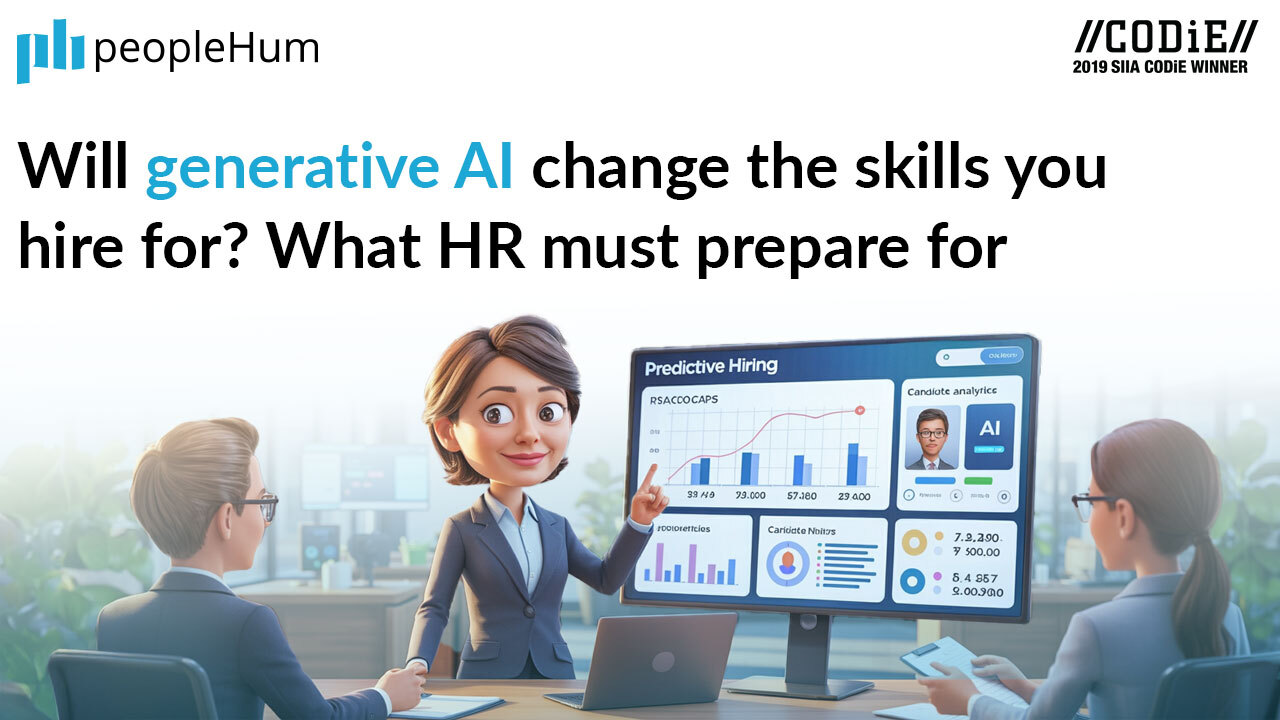Which skills should I train employees on right now?
As a HR leader, if you’ve typed this question into ChatGPT, Google, or your HR analytics tool, you’re not alone. Every HR leader faces the same challenge: budgets are tight, time is short, but the pressure to close skill gaps is increasing. We’ll make it easy for you - we'll walk you through seven of the most in-demand skills backed by surveys and industry reports that HR and L&D teams should consider prioritising this year.
What are the foundational principles of modern skill investment?
The days of reactive hiring, simply filling empty seats with external talent, are fading fast.The modern skillset isn't a random assortment; it's a strategically balanced portfolio across three core domains each essential for semantic matching when searching for training solutions. HR’s role is now to connect individual learning paths to the organization's macro-business objectives.
- The digital edge: This pillar addresses all things technological, from basic data literacy and cloud fluency to advanced proficiency in AI/ML tools.
- The cognitive core: These are the 'thinking' skills: how quickly an employee can analyze complex information, solve novel problems, or generate innovative ideas.
- The human connection: Often called 'soft skills’ they are the essential human competencies that machines cannot replicate, such as empathy, conflict resolution, leadership, and collaboration.
1. Data literacy & analytics fluency
This comprehensive skill moves beyond relying on intuition to become a data-driven strategic partner. It encompasses the foundational ability to understand and communicate with data, combined with the advanced application of gathering, interpreting, and modeling insights to directly inform organizational strategy and measure the financial return on talent investments.
Key features
- Data literacy: Ability to read and interpret charts, KPIs, dashboards
- Fundamentals of descriptive & predictive analytics: Foundational analysis, leading to forecasting
- Data translation : Converting raw data i.e numbers & metrics into clear, compelling narratives and actionable business recommendations - this is called data storytelling.
- Visualization tools: Proficiency in platforms like Tableau, Power BI, or advanced Excel to present insights effectively to non-technical stakeholders.
- Predictive modeling: Using data to forecast future trends, such as employee attrition rates or future skill shortages.
Pricing/Implementation
The tool (HRIS/Analytics Platforms) is the main cost driver. Entry-level analytics training (e.g. a workshop + online course) might cost USD 200–500 per learner. For deeper BI tool training or certification, costs could rise to USD 1,000–2,500 per person.
2. Emotional intelligence & resilience
This is the essential human capability to perceive, understand, and manage emotions (in self and others), coupled with the empathic ability to lead with understanding and the resilience to persist, recover, and adapt through uncertainty.These skills are critical for leadership, collaboration and navigating uncertainty. It is the master skill for conflict resolution, change management, and building inclusive, mentally healthy cultures, ensuring top talent is retained in complex work models.
Key features
- Self-awareness, self-regulation: The ability to manage one's own disruptive emotions and impulses effectively.
- Stronger employee retention: Employees stay when they feel seen, heard, and valued by high-EQ managers.
- Empathic leadership: Understanding an employee's perspective (their why) and using that to inform coaching and decision-making.
- Conflict resolution, active listening: Handling interpersonal relationships leads to higher engagement, lower burnout.
- Superior conflict resolution: Managers can de-escalate tensions and foster collaborative compromise.
- Stronger employee retention: Employees stay where they feel seen, heard, and valued by high-EQ managers.
Pricing/ImplementationWorkshops or cohort coaching often cost USD 400–1,000 per person (or group pricing). Peer coaching and mentoring add lower-cost, ongoing reinforcement. Many platforms now microdose EQ challenges for USD 50–150 per user.
3. Digital & AI augmentation skills
Generative AI, automation and smart tools are transforming how work gets done. They don’t replace humans, they amplify them. The skill here is not coding, it’s understanding how to work with AI and intelligent tools, knowing when to delegate tasks, and how to design workflows that integrate automation. Professionals who master this augmentation mindset can dramatically boost productivity and avoid obsolescence. This fluency is essential for upskilling and future-proofing staff against automation disruption, viewing AI as a partner to free up time for high-value strategy and relationship building.
Key features
- Prompt engineering & tool selection: The ability to craft precise, effective commands to get optimal output from AI tools.
- Tool integration: Seamlessly using AI assistants for tasks like summarizing documents, drafting communication, or basic data cleansing, and leveraging AI for learning design, content creation, and analytics support.
- Ethical AI use: Understanding bias in algorithms and ensuring fair, responsible application of automated decision-making and understanding AI limitations and ethical guardrails.
- Dramatic productivity gains: Automates administrative tasks, allowing employees to focus on high-value strategy and relationship building.
- Innovation acceleration: Provides new ways to approach old problems, fostering a culture of experimentation.
Pricing/Implementation
Many AI learning platforms offer modular courses for USD 100–300 per user. Enterprise licensing for AI tools (e.g. Copilot, content generation suites) may run USD 10–50 per user per month. Some organizations adopt pilot programs (e.g. 50 users) before scaling.
4. Creative innovation: Ideation and design thinking
This comprehensive skill is the ability to generate ideas and systematically translate them into human-centered, tested, and scalable solutions. It equips the organization to move beyond mere efficiency and embrace innovation as a structured, repeatable capability for solving "wicked problems" and achieving market differentiation.
Key features
- Divergent thinking: Generating a wide range of potential solutions from a single prompt or problem.
- Conceptual blending: Combining elements from different fields or industries to create a unique approach.
- Ideation, rapid prototyping: A bias toward action and testing ideas quickly.
- Experimentation, MVP (minimum viable product) thinking: Iteratively testing and refining solutions.
- Iterative refinement and scaling: Structuring the process to improve and deploy the final solution.
Pricing/Implementation
Utilizes design thinking workshops, internal 'hackathons,' and cross-departmental brainstorming retreats. Design thinking workshops with facilitators might cost USD 1,500–5,000 for a cohort. Coaching and innovation labs may add USD 200–500 per person. Over time, innovation toolkits and kits amortize cost across multiple projects.
5. Communication & collaborative virtual skills
Effective collaboration across time zones, cultures, and technologies is a core capability. The skill here involves clear communication, virtual meeting design, cross-functional collaboration habits, and digital etiquette among different departments like Marketing, HR, Finance, to work together seamlessly. It is crucial for breaking down internal silos, ensuring internal structures don’t sabotage external strategies, and maintaining high productivity in distributed teams.
Key features
- Shared goal setting: Establishing clear, overarching objectives that supersede individual departmental KPIs.
- Interdepartmental communication: Using clear, jargon-free language and setting consistent channels for information exchange.
- Conflict negotiation: The ability to mediate differences in priorities and resource allocation between two distinct teams.
- Writing with clarity in email / chat / documentation.
- Faster project delivery: Reduces bottlenecks and hand-offs between departments.
- Holistic problem solving: Solutions are informed by multiple perspectives (e.g., product and finance and HR).
- Increased internal mobility: Employees gain exposure to other functions, boosting internal career growth.
Pricing/Implementation
This can be achieved through project-based learning, matrixed team assignments, and collaboration software training. Training modules in effective virtual communication often run USD 100–300 per user.
6. Agility, adaptability, and adaptive learning
This is the essential capability for maintaining performance and well-being amid organizational, market, or technological turbulence. It combines the individual mindset to embrace continuous change, view mistakes as data, and quickly reorganize priorities, with the organizational practice of designing training that is responsive, iterative, and personalized to the learner’s needs and the business’s emerging needs. This skill ensures the organization can rapidly respond to market shifts and reduce burnout.
Key features
- Growth mindset: A belief that abilities and intelligence can be developed through dedication and hard work, not fixed traits.
- Ambidexterity: The ability to execute current tasks efficiently while simultaneously exploring new ways of working and learning new skills.
- Resilience: The capacity to recover quickly from difficulties, change, or misfortune, viewing setbacks as temporary.
- Learning pathways that adapt to learner pace, data: Personalizing and adjusting training in near real time.
- Feedback loops and rapid reflection: Embracing continuous learning and improvement.
- Organizational resilience: The business can rapidly respond to market shifts, competitor actions, and economic turbulence.
- Faster innovation cycles: Teams aren't afraid to fail fast and iterate on new products or processes.
Pricing/Implementation
Focuses on behavioral coaching, agile methodology certification, and psychological safety workshops. Adopting agile L&D frameworks might cost ~USD 5,000–15,000. Learning technology platforms with adaptive features may charge USD 5–20 per user per month.
7. Cybersecurity awareness & risk management
Cyber threats are no longer confined to IT teams; any employee is a potential entry point. Handling sensitive information is a routine part of modern business, making it vital that all employees are skilled in cybersecurity awareness and basic risk management. This is a foundation skill that supports trust, compliance, and organizational resilience.
- Phishing detection and response: Recognizing deceptive attempts to steal sensitive information or compromise systems.
- Safe data handling and encryption basics: Understanding proper procedures and storing, transmitting, and disposing of sensitive information.
- Access control, identity management awareness: Knowing the principles of least privilege and use multi-factor authentication (MFA) and strong passwords which ensure only authorized users can access specific resources and data.
- Incident reporting and escalation pathways: Clearly understanding what constitutes a security incident and reporting it for timely containment and remediation.
Pricing/Implementation
Basic cybersecurity awareness training can cost USD 20–100 per user (online modules). More advanced or role-specific training (e.g. for HR or finance) might cost USD 300–600 per user. Some platforms charge a flat per-organization license fee.
Wrapping it up
L&D leaders should consider investing in tomorrow’s needs - from data literacy to design thinking, from emotional intelligence to AI augmentation. These skills reflect the shifting demands of work, technology, and human engagement. Run a targeted skills gap audit, pick one or two skills to pilot, collect data, and scale iteratively. Over time, this approach can change HR from a support center to a strategic capability engine.































%20(1).jpg)




%20(1).jpg)













